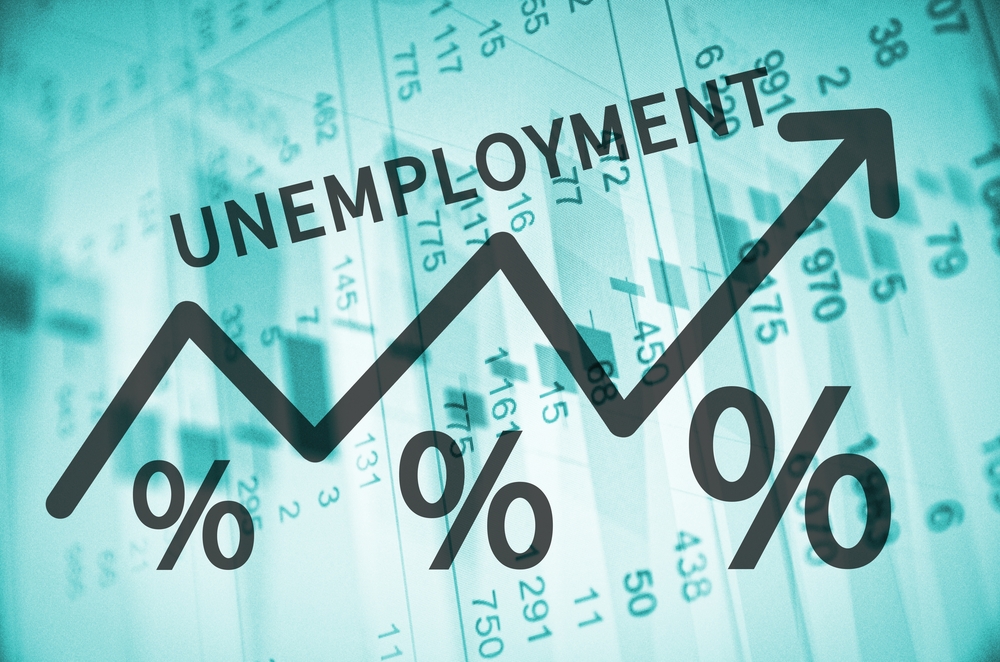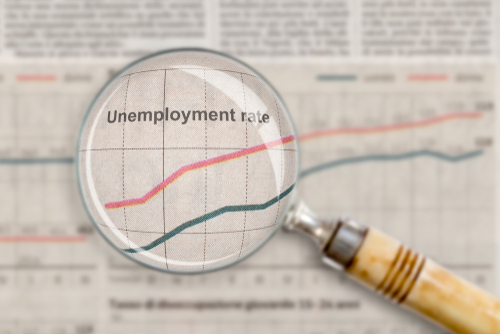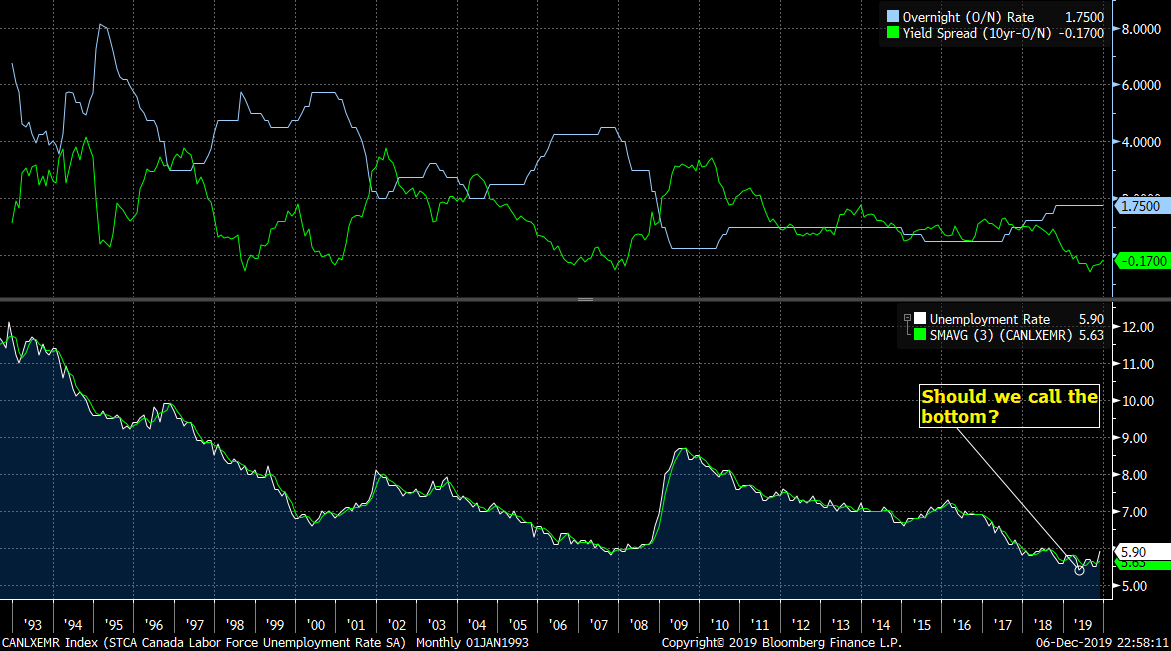 Canada just witnessed its worst spike in unemployment since the Great Recession of 2009. An estimated 71,200 jobs were lost in November.
Canada just witnessed its worst spike in unemployment since the Great Recession of 2009. An estimated 71,200 jobs were lost in November.
And we all know what happens when unemployment bottoms and starts climbing.
Rates usually drop.
Is This Really the Bottom in Unemployment?
No one knows what tomorrow will bring (until tomorrow). But here’s what we know:
- Economic cycles have to end sometime.
- Canada’s expansion is looking long in the tooth.
- Bottom formations in unemployment (like we see today) generally lead to rising unemployment.
- The risk of assuming unemployment is not bottoming is probably greater than the risk of assuming it is.
Let’s go to the charts…
The graph above plots:
- The Bank of Canada overnight rate (the foundation of Canadian interest rates)
- The yield curve
- Also called the “yield spread,” it equals the 10-year government yield minus the overnight rate.
- When this spread turns negative it usually signals a coming recession (which portends lower rates).
- It’s been negative for over five months.
- The unemployment rate
- When the unemployment rate bases out after a long drop and starts turning up, more often than not rates flatten out or start dropping soon after.
The Question This Raises
Friday’s ominous 0.40-percentage-point surge in unemployment could be a harbinger of one of the following outcomes:
A) The next major down-cycle in interest rates, or
B) An extended sideways trend.
(This assumes Friday’s unemployment figure is not significantly revised by StatsCan, which is unlikely but possible.)
If you’re a well-qualified borrower who can pick from any mortgage term, this begs an important question: Should you heed these market clues and go short-term or variable, or should you stick with a 5-year fixed?
One Possibility
In my chat with BNN’s Greg Bonnell this week, a question came up about where rates are headed. I’ll elaborate here on what I told him:
- In the short-to-medium term, positive news out of the U.S. could potentially take rates higher
- No one knows how much; maybe 20 to 40+ bps in the months that follow.
 One obvious catalyst would be a U.S./China trade deal. Or it may just be further blockbuster economic data, like Friday’s blowout U.S. employment numbers.
One obvious catalyst would be a U.S./China trade deal. Or it may just be further blockbuster economic data, like Friday’s blowout U.S. employment numbers.- Remember, Canadian rates follow U.S. rates the majority of the time.
- Longer-term, the balance of indicators still suggest a better chance of lower rates than higher rates in Canada.
- The “balance of indicators” refers to:
- The factors mentioned above (unemployment potentially bottoming, the inverted yield curve, etc.), and
- Long-term structural trends that lower the chance of materially higher rates, like central bank inflation targeting, tech innovation (Amazon.com, 5G, A.I., robotics, etc.), offshoring/outsourcing, an aging population, lower savings rates, etc., and
- The simple fact that rates are random and more likely to trend sideways or down than up in any five-year span.
- The “balance of indicators” refers to:
Knowing #1 doesn’t help you as a mortgage shopper other than to remind you to get a rate hold fast if: (A) a positive trade deal is announced; and (B) you’ll need a fixed-rate mortgage in the following 3-5 months.
Observation #2 is more relevant to your borrowing costs over the next five years. It suggests the odds of success are best in a term that:
A) lets you adjust your mortgage rate lower if rates drop, and
B) reduces your risk of paying a penalty, and
C) has the biggest up-front interest rate savings.
What Meets That Criteria Today?
The optimal term depends on a lot of things, not the least of which are the mortgage’s loan-to-value (LTV), the borrower’s finances and his/her “five-year plan” as we like to call it.
 For these purposes, we’ll assume the borrower has good credit, sufficient provable income and can get approved at most banks.
For these purposes, we’ll assume the borrower has good credit, sufficient provable income and can get approved at most banks.
As we speak, the term that best meets the above criteria and offers an optimal mix of…
- flexibility (letting you refinance to a lower rate sooner, if rates drop)
- convenience (ensuring you avoid a renewal hassle in 12 months, which you’d face in a slightly cheaper 1-year fixed term)
- risk/reward (helping you avoid prepayment penalties if you have to break or refinance sooner than expected)
- upfront savings
…is the 2-year fixed.
Two-year fixed rates are starting at 2.49% to 2.58%. That makes them cheaper than most 5-year fixed rates. If the Bank of Canada takes rates down in 2020—as the market expects—a two-fer could put a big smile on your face.
The Exception Case
A shorter or variable term won’t be everyone’s cup of tea. Some folks may be better suited to a 5-year fixed, particularly those who:
 may have a harder time qualifying in the future (due to income loss, for example)
may have a harder time qualifying in the future (due to income loss, for example)- may incur financial damage if rates surge due to unforeseeable inflationary events like:
- an oil shock (granted, this is much less likely today given how diversified oil supply has become)
- escalating tariff wars
- runaway debt and deficits spooking credit markets
- a technological revolution that increases aggregate consumer demand (e.g., new low-cost “limitless” energy sources, transportation breakthroughs, or even a cure for cancer)
Odds are, long-term disinflationary trends will trump random inflation shocks. But some people can’t (shouldn’t) take that gamble. What they’d lose in a 5-year fixed if rates dropped would be far less impactful than what they’d lose in a short term or variable rate if rates soared.

 log in
log in

4 Comments
Canadian Business Investment Drops To 25-Year Low, Sparking Questions About Job Growth
https://www.huffingtonpost.ca/entry/business-investment-canada_ca_5db9e134e4b0bb1ea373ed05
Guess that story was right on the mark.
The CN rail strike may have skewed the November unemployment number a bit as there were a fair bit of temporary layoffs.
If rates might go down would a variable be better than a 2 year fix I wonder? Anyone have an opinion on this?
Thanks
Hi Add, Temporary layoffs from CN Rail didn’t have a major impact on these figures according to economist reports we saw. To paraphrase Ben Tal, no
amount of lipstick can make this pig any prettier (election-related job losses and labour force survey volatility notwithstanding).